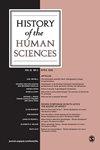Maps of desire: Edward Tolman's drive theory of wants
IF 0.5
2区 历史学
Q2 HISTORY & PHILOSOPHY OF SCIENCE
引用次数: 0
Abstract
Wants and desires are central to ordinary experience and to aesthetic, philosophical, and theological thought. Yet despite a burgeoning interest in the history of emotions research, their history as objects of scientific study has received little attention. This historiographical neglect mirrors a real one, with the retreat of introspection in the positivist human sciences of the early 20th century culminating in the relative marginalization of questions of psychic interiority. This article therefore seeks to explain an apparent paradox: the attempt to develop a comprehensive theory of ‘why … we want what we want’ in the 1940s by esteemed American ‘neo-behaviorist’ psychologist Edward Tolman – a proponent of a methodology famous for its prohibition on appeals to unobservable mental phenomena. Though chiefly known today for his theory of ‘cognitive maps’, Tolman also sought to map the contours of desire as such, integrating Freudian and behaviorist models of the ‘drives’ to develop a complex iconography of the universal structures of motivation. Close attention to Tolman's striking maps offers a compelling limit case for what could and could not be captured within an anti-mentalist framework, and illuminates an important precursor to theories of motivational ‘affect’ in the postwar cognitive and neurosciences. His work upsets a standard chronology that centers on the ‘cognitive revolution’ of the 1960s, and points to the significance of psychoanalysis to an earlier turn to cognitivism. Tolman concluded his theory pointed ‘in the direction of more socialism’ – a reminder of the politically labile anti-essentialism of behaviorism's commitment to mental plasticity.欲望地图:爱德华·托尔曼的欲望驱动理论
欲望和欲望是普通经验以及美学、哲学和神学思想的核心。然而,尽管人们对情感史的研究兴趣与日俱增,但作为科学研究对象的情感史却很少受到关注。这种历史上的忽视反映了一种真实的忽视,20世纪初实证主义人文科学中内省的消退最终导致了心理内在性问题的相对边缘化。因此,这篇文章试图解释一个明显的悖论:受人尊敬的美国“新行为主义”心理学家爱德华·托尔曼在20世纪40年代试图发展一个关于“为什么……我们想要我们想要的”的综合理论,他是一种以禁止诉诸于不可观察的心理现象而闻名的方法论的支持者。尽管托尔曼今天主要以他的“认知地图”理论而闻名,但他也试图绘制欲望的轮廓,将弗洛伊德和行为主义的“驱动力”模型相结合,以形成动机普遍结构的复杂图像。对托尔曼引人注目的地图的密切关注为在反精神主义框架内可以捕捉到什么和不能捕捉到什么提供了一个令人信服的极限案例,并阐明了战后认知和神经科学中动机“影响”理论的一个重要先驱。他的作品颠覆了以20世纪60年代“认知革命”为中心的标准年表,并指出了精神分析对早期转向认知主义的意义。托尔曼总结说,他的理论指向“更多社会主义的方向”——这提醒人们行为主义对心理可塑性的承诺在政治上是不稳定的反本质主义。
本文章由计算机程序翻译,如有差异,请以英文原文为准。
求助全文
约1分钟内获得全文
求助全文
来源期刊

History of the Human Sciences
综合性期刊-科学史与科学哲学
CiteScore
1.60
自引率
11.10%
发文量
31
审稿时长
>12 weeks
期刊介绍:
History of the Human Sciences aims to expand our understanding of the human world through a broad interdisciplinary approach. The journal will bring you critical articles from sociology, psychology, anthropology and politics, and link their interests with those of philosophy, literary criticism, art history, linguistics, psychoanalysis, aesthetics and law.
 求助内容:
求助内容: 应助结果提醒方式:
应助结果提醒方式:


